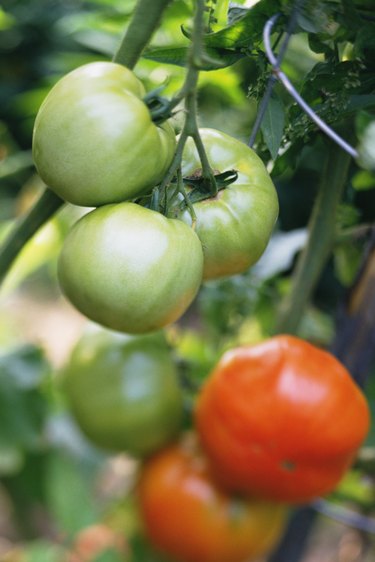
According to the University of Missouri, tomato plants are the most popular vegetable grown in home gardens because of the abundant fruit and easy care. Low in calories, rich in vitamins A and C, ripe tomatoes are an ideal source of lycopene, the pigment chemical that colors a ripe tomato red. As healthful and beneficial as tomatoes are, the plant and fruit also contain the poisonous toxin solanine.
Solanine
Video of the Day
Tomato plants are a member of the nightshade family, along with peppers, potatoes and eggplant, and all nightshade plants contain levels of the alkaloid toxin solanine in the plant's roots, stems, leaves and fruit. Solanine is the natural defense the plant has to protect itself from animals consuming and destroying it. Solanine is a bitter tasting glyco-alkaloid that is poisonous, even in small concentrations. Green-skinned potatoes have the highest toxic levels of solanine, much greater and more harmful than the solanine content of tomatoes.
Video of the Day
Green Tomatoes
Green tomatoes contain the highest concentration of the alkoloid solanine, called tomatine. Up to 500 mg per 1 kg of fruit weight can be found in an immature, green tomato. In many regions of the United States, especially in the south, green tomatoes are used in culinary creations, usually in relishes or fried. The green tomatoes used in these dishes are in the early stages of ripening, though still green to green yellow color, and contain lesser amounts of solanine than the harder, immature green tomato. Additionally, frying the green tomatoes in hot oil diminishes the solanine content, rendering the green tomato less toxic.
Red Tomatoes
The solanine, or tomatine, level dramatically decreases in fully ripe tomatoes, to levels less than 5 mg per 1 kg of fruit weight. These low levels pose no health problems to humans, but even in the ripened form the solanine remaining in a tomato is harmful to cats. Vine ripened tomatoes, fresh from the garden are the safest for low solanine content. Hothouse grown tomatoes that are often sold in grocery stores will contain higher levels of solanine. This is because the hothouse and commercial tomatoes have been harvested while the fruit is still green, just beginning to turn, and still have a firm, hard feel. The softer and sweeter the ripe tomato is, the less solanine it contains.
Symptoms
Reaction to solanine poisoning can be as quickly as 30 minutes after consuming green tomatoes to as long as 8 to 12 hours later. Gastrointestinal disorders including diarrhea, stomach cramps, nausea, vomiting and burning of the throat. Neurological symptoms are dizziness, headaches and dsyrhythmia. Children and people with tomato allergies and sensitivity are the most affected by the solanine in green tomatoes.
- California Polytechnic State University; NightShade Alkaloid Toxins; Lisa Branstad
- Dr. Abdul Aljuboori: Beware Eating Green (Unripe) Potatoes, Tomatoes and Eggplant
- Journal of Agricultural and Food Chemistry; Tomato Glycoalkaloids: Role in the Plant and in the Diet; Mendel Friedman; 2002
- Juicing for Health: Tomato-Nutrition Information And Facts
- University of Missouri; Growing Home Garden Tomatoes; David H. Trinklein; April, 2010